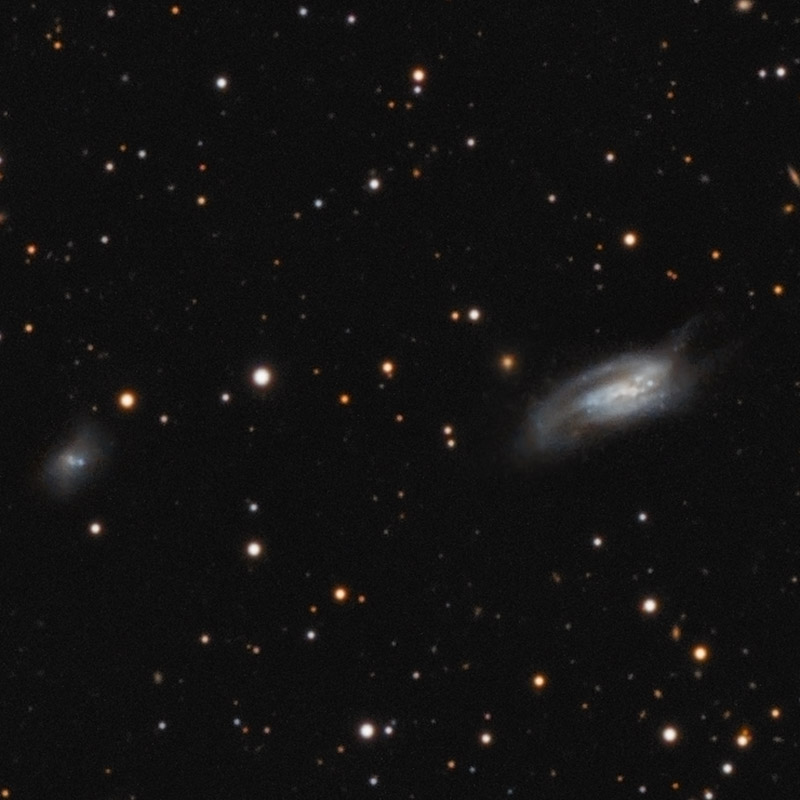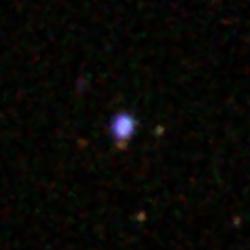Object name: NGC6239 NGC 6239 is a very disturbed spiral in Hercules. Redshift puts it about 42 million light-years distant but other measurements place it much further away ranging from 61 to 83 million light-years with a median value of 73 million I show in the annotated image. If the 42 million light-year figure is right then the main part of the galaxy (not including the loops to the east and plumes to the west is only 18,500 light years in diameter. That's pretty dinky. If the 83 million light-year figure is used then it is a more reasonable 37 million light-years in diameter, about the size of M33 for example. Thus I tend to think the larger Tully-fisher determined distances of 73 to 83 million light-years may be more accurate. It was discovered by William Herschel on April 12, 1788. It is in the second H400 program.
In any case this galaxy appears to have loops on the eastern side and plumes on the western side that indicate some hapless even smaller galaxy was digested by it in the recent past. To the east is AGC 262744 or PGC 2204813 if you prefer that catalog. It has virtually the same redshift and is also highly disturbed looking. Is this also due to an encounter with NGC 6239? Seems possible. An old note (1964) at NED seems to think so. It reads: "Bright complex bar. One short, bright arm. Double outer loop (a helix?). Very faint asymmetric extensions. A most peculiar system! Small colliding pair at 7.5 arcmin." Another indicates there is strong emission spectra (probably HII related) coming from the bar though I didn't pick it up and another note based on a 200" Palomar image also failed to see the HII regions blaming them on being below their seeing limit. So it is no wonder I didn't see them. NED however does classify NGC 6239 as SB(s)b pec? HII. Another to try with the H alpha filter sometime. I've included a very simple process of a raw HST image of the core region of NGC 6239 that shows the star-like objects in the core region of my image are all star knots in the galaxy. Also I see little hint of resolution of the major stars of the galaxy in the HST image. This argues for the a distance greater than redshift would indicate as normally the HST easily resolves a ton of starsNGC 6239 is a very disturbed spiral in Hercules. Redshift puts it about 42 million light-years distant but other measurements place it much further away ranging from 61 to 83 million light-years with a median value of 73 million I show in the annotated image. If the 42 million light-year figure is right then the main part of the galaxy (not including the loops to the east and plumes to the west is only 18,500 light years in diameter. That's pretty dinky. If the 83 million light-year figure is used then it is a more reasonable 37 million light-years in diameter, about the size of M33 for example. Thus I tend to think the larger Tully-fisher determined distances of 73 to 83 million light-years may be more accurate. It was discovered by William Herschel on April 12, 1788. It is in the second H400 program.
In any case, this galaxy appears to have loops on the eastern side and plumes on the western side that indicate some hapless even smaller galaxy was digested by it in the recent past. To the east is AGC 262744 or PGC 2204813 if you prefer that catalog. It has virtually the same redshift and is also highly disturbed looking. Is this also due to an encounter with NGC 6239? Seems possible. An old note (1964) at NED seems to think so. It reads: "Bright complex bar. One short, bright arm. Double outer loop (a helix?). Very faint asymmetric extensions. A most peculiar system! small colliding pair at 7.5 arcmin." Another indicates there are strong emission spectra (probably HII related) coming from the bar though I didn't pick it up and another note based on a 200" Palomar image also failed to see the HII regions blaming them on being below their seeing limit. So it is no wonder I didn't see them. NED, however, does classify NGC 6239 as SB(s)b pec? HII. I've included a very simple process of a raw HST image of the core region of NGC 6239 that shows the star-like objects in the core region of my image are all star knots in the galaxy. Also, I see little hint of resolution of the major stars of the galaxy in the HST image. This argues for a distance greater than redshift would indicate as normally the HST easily resolves a ton of stars in a galaxy at 42 million light-years but few at 80.
AGC 262744 is pretty much ignored by NED as to classification and any published notes on it. So I can't help further with it.
Sometimes serendipity strikes. It has in this case. Look to the annotated image for SDSS J1650+4251 to the upper left of NGC 6239. It is the combined light of a galaxy at some 5.6 billion light-years and a lensed quasar at almost 9.5 billion light-years. Thanks to my lousy seeing I can't separate the two. I doubt any of the galaxy's light is seen and all I'm picking up is multiple images of the quasar. As seen in the SDSS image it appears to be a lensed into two or maybe three blue blobs of light. The SDSS image is at 0.2" per pixel. I can't see the lensing galaxy in their image either. There is a color difference that may indicate the galaxy is mixed with the southern image of the quasar. It may show only spectroscopically as a separate object. I had no idea it was in the image until I asked NED for what all was in the image that had a measured redshift. This isn't the first surprise I've had doing this. It happens every few months. Another reason to research your images. You might find a pleasant surprise lurking there you never suspected such as this lensed quasar.
Otherwise, the image is rather typical of what I'd expect imaging in Hercules. Several galaxy clusters and lots of distant galaxies. I've added a new flag on the distance estimates. Most are redshift determined spectroscopically using NED's 5 year WMAP calculator. Those with a "p" after the distance. One, however, has the label of "f". That stands for "Friend of Friend" which is used when it is assumed the object is related to others and its distance uses other well determined redshifts of assumed nearby objects to calculate its distance estimate.
14" LX200R @ f/10, L=4x10' RGB=2x10', STL-11000XM, Paramount ME in a galaxy at 42 million light-years but few at 80.
AGC 262744 is pretty much ignored by NED as to classification and any published notes on it. So I can't help further with it.
Sometimes serendipity strikes. It has in this case. Look to the annotated image for SDSS J1650+4251 to the upper left of NGC 6239. It is the combined light of a galaxy at some 5.6 billion light-years and a lensed quasar at almost 9.5 billion light-years. Thanks to my lousy seeing I can't separate the two. I doubt any of the galaxy's light is seen and all I'm picking up is multiple images of the quasar. As seen in the SDSS image it appears to be a lensed into two or maybe three blue blobs of light. The SDSS image is at 0.2" per pixel. I can't see the lensing galaxy in their image either. There is a color difference that may indicate the galaxy is mixed with the southern image of the quasar. It may show only spectroscopically as a separate object. I had no idea it was in the image until I asked NED for what all was in the image that had a measured redshift. This isn't the first surprise I've had doing this. It happens every few months. Another reason to research your images. You might find a pleasant surprise lurking there you never suspected such as this lensed quasar.
Otherwise the image is rather typical of what I'd expect imaging in Hercules. Several galaxy clusters and lots of distant galaxies. I've added a new flag on the distance estimates. Most are redshift determined spectroscopically using NED's 5 year WMAP calculator. Those with a "p" after the distance. One however has the label of "f". That stands for "Friend of Friend" which is used when it is assumed the object is related to others and its distance uses other well determined redshifts of assumed nearby objects to calculate its distance estimate.
14" LX200R @ f/10, L=4x10' RGB=2x10', STL-11000XM, Paramount ME Related Designation(s):2MASS J16500504+4244234, 2MASX J16500502+4244234, 2MASXi J1650050+424423, AKARI J1650045+424422, ASK 118578.0, ASK 118579.0, CGCG 1648.5+4250, CGCG 224-105, CGCG 225-002, IRAS 16484+4249, IRAS F16485+4249, MCG +07-35-001, NGC 6239, NGC6239, NSA 167111, NVSS J165005+424422, PGC 059083, SDSS J165004.83+424422.9, SDSS J165004.86+424423.0, SDSS J165004.96+424422.5, SDSS J165004.98+424422.8, UGC 10577, UZC J165005.3+424422, [MGD2014] 1648.4+4249, | | 


